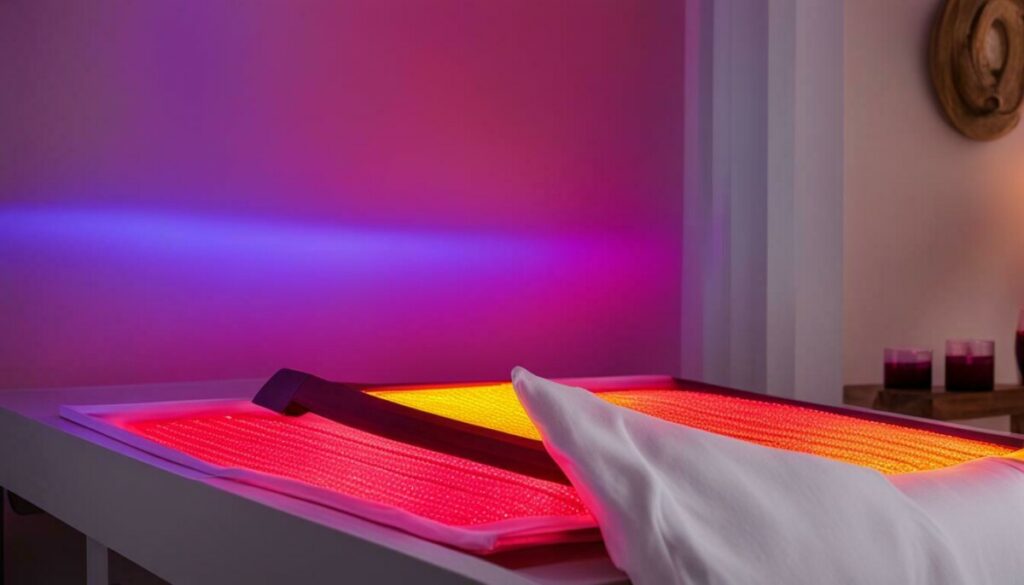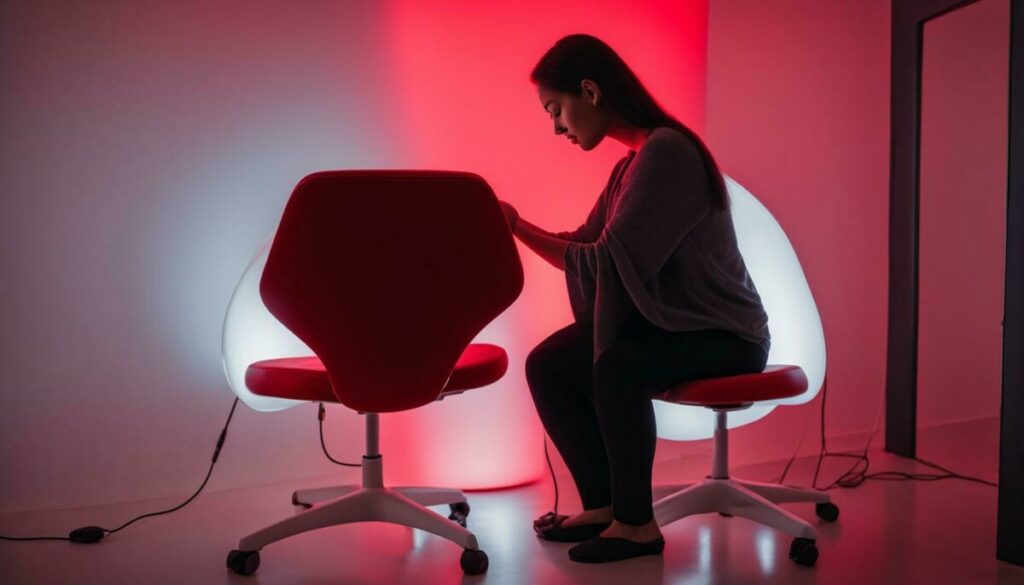Last Updated on 6 months by Francis
Are you struggling with skin concerns or looking to improve your overall health? Light therapy may be the solution for you. However, with so many options available, it can be challenging to know which treatment to choose. In this article, we will compare yellow light therapy and red light therapy to determine which is best for your needs.
Contents
Key Takeaways:
- Yellow light therapy and red light therapy are both effective treatments for rejuvenating the skin and promoting health.
- Yellow light therapy primarily targets the upper layers of the skin, making it ideal for treating surface-level concerns, while red light therapy penetrates deeper into the skin, providing more profound rejuvenation effects.
- Yellow light therapy promotes collagen production and improves skin elasticity, while red light therapy reduces pain and inflammation.
- The choice between yellow light therapy and red light therapy depends on your specific needs and goals.
- Both therapies can be easily incorporated into your skincare routine with various devices available for at-home use.
Understanding Yellow Light Therapy
Yellow light therapy is a non-invasive treatment that targets various skin concerns using specific wavelengths of yellow light. It is becoming increasingly popular in the skincare industry due to its many benefits.
Benefits of Yellow Light Therapy:
- Reduces inflammation
- Promotes collagen production
- Improves skin elasticity
- Soothes redness
- Minimizes the appearance of sunspots, age spots, and hyperpigmentation
Many people also use yellow light therapy for non-skin related concerns like improving mood, increasing energy levels, and regulating sleep patterns.
One of the significant advantages of yellow light therapy is that it can be used in combination with other skincare treatments for optimal results. For instance, when used with red light therapy, it can help target different levels of the skin, providing deeper rejuvenation effects.
Usage of Yellow Light Therapy
Yellow light therapy can be used to treat a wide range of skin concerns, including acne, rosacea, and psoriasis. It can also help improve the overall texture and tone of your skin, leaving you with a glowing and youthful appearance.
Yellow light therapy is particularly effective when used consistently over an extended period. For best results, it is recommended to use yellow light therapy devices for at least 10 to 15 minutes per day.

“Yellow light therapy is an excellent addition to any skincare routine, providing numerous benefits for the skin and overall well-being.”
Exploring Red Light Therapy
Red light therapy is a popular non-invasive treatment that utilizes specific wavelengths of red light to stimulate cellular repair and regeneration. This treatment is known for its numerous benefits for the skin and overall health.
One of the primary advantages of red light therapy is its ability to reduce pain and inflammation. The treatment can be helpful in relieving chronic pain conditions such as arthritis, muscle soreness, and joint stiffness. Studies have shown that red light therapy can stimulate the release of endorphins, which are natural painkillers, reducing the need for medication.

In addition to its pain relief benefits, red light therapy can also improve skin texture and tone. By penetrating deep into the skin, red light therapy can promote cellular regeneration and collagen production, leading to younger-looking skin with reduced appearance of fine lines and wrinkles.
Red light therapy has also been shown to be effective in accelerating wound healing. The treatment can help reduce inflammation, stimulate the growth of new blood vessels, and promote the formation of new tissue, leading to faster healing times.
Overall, red light therapy is a versatile treatment that can provide numerous benefits for the skin and overall health. With its ability to reduce pain and inflammation, improve skin texture and tone, and accelerate wound healing, red light therapy is a popular and effective treatment option.
Key Differences between Yellow Light Therapy and Red Light Therapy
Yellow light therapy and red light therapy are both popular treatments that offer a variety of benefits. While they share some similarities, there are also some key differences between the two. Understanding these differences can help you choose the treatment that is best for you.
| Yellow Light Therapy | Red Light Therapy |
|---|---|
| Primarily targets the upper layers of the skin | Penetrates deeper into the skin |
| Ideal for treating surface-level concerns | Provides more profound rejuvenation effects |
| Reduces inflammation | Reduces pain and inflammation |
| Promotes collagen production and improves skin elasticity | Accelerates wound healing and improves skin texture and tone |
Yellow light therapy primarily targets the upper layers of the skin, making it ideal for treating surface-level concerns such as acne, sun damage, and age spots. It also promotes collagen production and improves skin elasticity, resulting in a more youthful appearance. In addition, yellow light therapy has been shown to reduce inflammation, making it an effective treatment for skin conditions such as rosacea and psoriasis.
Red light therapy, on the other hand, penetrates deeper into the skin, making it more effective for addressing issues such as pain and inflammation. It accelerates wound healing, improves skin texture and tone, and provides more profound rejuvenation effects. Red light therapy is commonly used to treat chronic pain conditions, such as arthritis and muscle soreness, as well as injuries, such as sprains and strains.
Ultimately, the choice between yellow light therapy and red light therapy depends on your specific needs and goals. If you are primarily looking to address surface-level skin concerns, yellow light therapy may be the better option. However, if you are seeking pain relief or more profound skin rejuvenation, red light therapy would be more suitable.
How Yellow Light Therapy Works
Yellow light therapy works by stimulating the production of ATP (adenosine triphosphate) in skin cells. ATP is the energy currency of cells, and by increasing its production, yellow light therapy helps cells function optimally, leading to improved skin health and vitality.
When applied to the skin, yellow light therapy penetrates the epidermis and dermis layers, stimulating a photo-chemical response. The yellow light activates biological processes that help reduce inflammation, promote collagen production, improve skin elasticity and texture, and enhance overall skin health.
Yellow light therapy is an ideal treatment for those with skin concerns such as fine lines and wrinkles, acne, rosacea, and uneven skin tone. Additionally, it can help regulate sleep patterns, alleviate symptoms of depression and anxiety, and improve mood and energy levels. With regular use, yellow light therapy can help you achieve a brighter, healthier-looking complexion.

How Red Light Therapy Works
In red light therapy, specific wavelengths of red light penetrate deep into the skin, promoting cellular repair and regeneration. This is achieved by stimulating the mitochondria in cells, which are responsible for producing energy. The red light stimulates the production of ATP in mitochondria, which leads to increased energy production and improved cellular function.
The increased energy production promotes cellular repair, leading to improved skin health and pain relief. Red light therapy has been shown to reduce inflammation and promote collagen production, making it beneficial for improving skin texture and tone. It is particularly effective in reducing the appearance of fine lines and wrinkles, as well as enhancing overall skin elasticity.

Red light therapy can also improve mental health by promoting relaxation and reducing symptoms of anxiety and depression. It has been shown to stimulate the release of endorphins, which are natural painkillers, making it an excellent therapy for pain relief.
Overall, red light therapy offers numerous benefits for skin health and overall well-being. Its ability to penetrate deep into the skin and promote cellular regeneration makes it a popular choice for those seeking pain relief and profound skin rejuvenation.
Yellow Light Therapy for Skin
If you’re looking for a non-invasive treatment to rejuvenate your skin and reduce inflammation, yellow light therapy may be the solution for you. Yellow light therapy utilizes specific wavelengths of yellow light to target various skin concerns, making it ideal for those wanting to enhance the look and feel of their skin.

One of the primary benefits of yellow light therapy for skin is its ability to reduce inflammation, which can help soothe redness and irritation. It can also help improve overall skin tone, minimizing the appearance of sunspots, age spots, and hyperpigmentation, resulting in a more even complexion.
Yellow light therapy has also been shown to promote collagen production and improve skin elasticity, leading to smoother, more youthful-looking skin. Additionally, many people use yellow light therapy to improve mood and boost energy levels.
Red Light Therapy for Pain Relief: How It Works
Red light therapy has gained significant attention in recent years due to its potential to help alleviate chronic pain conditions. This therapy works by penetrating deep into the skin and stimulating cellular repair and regeneration, resulting in improved pain relief and reduced inflammation.
The effects of red light therapy on pain relief have been extensively studied, with multiple studies showing a significant reduction in pain levels. Red light therapy is thought to stimulate the release of endorphins, which are natural painkillers that help reduce discomfort and promote an overall sense of well-being.
Additionally, red light therapy has been shown to be effective in treating various pain conditions, such as arthritis, muscle soreness, and joint stiffness. It can also help accelerate the healing process for injuries, reducing recovery times and improving mobility.
The Science Behind Red Light Therapy for Pain Relief
The mechanism behind red light therapy’s pain relief benefits is related to the effects of light on cellular functioning. Red light therapy stimulates the mitochondria in cells to produce more energy, leading to an increase in cellular repair and regeneration. This increased activity helps reduce inflammation and promote healing, leading to a reduction in pain levels.
Moreover, red light therapy has been shown to have antioxidant effects that help reduce oxidative stress and inflammation, further contributing to its pain-relieving properties. By targeting the root causes of pain and inflammation, red light therapy can provide long-lasting relief for individuals suffering from chronic pain conditions.

Is Red Light Therapy Safe?
Red light therapy is considered a safe and non-invasive treatment option for pain relief. It does not cause any damage to surrounding tissue, and there are no known significant side effects associated with its use.
However, individuals with certain medical conditions should consult with a healthcare professional before starting red light therapy. Pregnant women, individuals with a history of seizures or epilepsy, or anyone taking medication that increases sensitivity to light should avoid using red light therapy without first consulting their doctor.
Incorporating Red Light Therapy into Your Pain Management Routine
Red light therapy devices are widely available for at-home use, making it easy to incorporate this therapy into your pain management routine. There are handheld devices and light panels that you can use to target specific areas of pain or inflammation.
It is important to follow the manufacturer’s instructions when using red light therapy devices to ensure you use them safely and effectively. If you have any underlying medical conditions, it’s always best to consult with a healthcare professional before starting any new treatment.
Overall, red light therapy is a promising treatment option for individuals seeking safe and effective pain relief. Its non-invasive nature and lack of significant side effects make it an attractive alternative to traditional pain management treatments.
Advantages of Yellow Light Therapy
Yellow light therapy is an excellent treatment for improving skin health and overall well-being. The benefits of yellow light therapy can be seen both on the surface of the skin and within the body.
Benefits for Skin
Yellow light therapy can help reduce inflammation, which is beneficial for those with acne-prone skin or rosacea. It can also improve skin tone and texture, making it an excellent treatment for those with sun damage or hyperpigmentation. Additionally, yellow light therapy can boost collagen production, resulting in firmer, smoother skin.

Other Benefits
Beyond skin health, yellow light therapy offers other advantages. It can help regulate sleep patterns, leading to more restful sleep and increased energy during the day. Some users have also reported a boost in mood and a reduction in symptoms of depression. Additionally, yellow light therapy has been shown to improve cognitive function and memory recall.
If you’re looking for a non-invasive, natural way to improve your skin health and overall well-being, yellow light therapy may be the answer.
Advantages of Red Light Therapy
Red light therapy provides numerous benefits for the skin and overall well-being. Here are some of the key advantages:
| Benefit | Details |
|---|---|
| Promotes cellular regeneration | Red light therapy stimulates the mitochondria in cells, promoting increased energy production and cellular repair and regeneration. |
| Improves skin texture | Red light therapy can help reduce the appearance of fine lines and wrinkles, and improve overall skin texture and tone. |
| Enhances collagen production | Red light therapy has been shown to improve collagen production, leading to firmer, more youthful-looking skin. |
| Faster wound healing | Red light therapy can accelerate the healing of wounds by promoting cellular regeneration and reducing inflammation. |
| Pain relief | Red light therapy can reduce pain and inflammation, making it effective for treating conditions such as arthritis, muscle soreness, and joint stiffness. |
| Positive effects on mental health | Red light therapy has been shown to promote relaxation and reduce symptoms of anxiety and depression. |
With all of these benefits, it’s no wonder that red light therapy has become such a popular treatment option in recent years. Whether you’re looking to improve the appearance of your skin, accelerate wound healing, or alleviate pain, red light therapy can be a safe and effective solution.

Choosing the Right Therapy for You
Deciding which therapy is right for you ultimately depends on your specific needs and goals. Yellow light therapy is ideal for surface-level skin concerns, such as reducing inflammation and improving skin tone. On the other hand, red light therapy is better for pain relief and more profound skin rejuvenation, promoting collagen production and cellular regeneration.
Consider your priorities and consult with a healthcare professional to determine which treatment is best for you. It’s important to note that both yellow light therapy and red light therapy can be easily incorporated into your skincare routine with various devices available for at-home use, including handheld LED devices and light therapy masks.
Experiment and find the therapy that works best for you. Incorporating light therapy into your routine can lead to noticeable improvements in skin texture and pain relief, as well as overall well-being.

Incorporating Light Therapy into Your Routine
If you’re interested in trying yellow light therapy or red light therapy, there are several ways to incorporate these treatments into your daily routine. One option is to visit a spa or wellness center that offers light therapy sessions. During these sessions, you will typically lie down or sit in front of a light therapy device for a designated period of time while the specific wavelengths of light work their magic.
Alternatively, you can purchase an at-home light therapy device to use on your own. These devices come in various forms, including handheld wands, light panels, and masks. When using an at-home device, it’s important to follow the manufacturer’s instructions carefully, as overuse or improper use can lead to unwanted side effects.
When incorporating yellow light therapy or red light therapy into your routine, it’s essential to be patient. While some people may notice immediate results, it can take several weeks of consistent use to see significant improvements in skin texture, pain relief, or other targeted areas.
Uses of Yellow Light Therapy
Yellow light therapy can be used to target several different skin concerns. Its anti-inflammatory properties make it an effective treatment for reducing redness and irritation, including rosacea. Yellow light therapy can also help to improve overall skin tone, minimize the appearance of fine lines and wrinkles, and reduce the appearance of sunspots, age spots, and hyperpigmentation.
In addition to its skin benefits, yellow light therapy can help to regulate sleep patterns and improve mood. It has also been shown to have anti-depressant effects, making it a useful treatment for individuals dealing with depression or other mood disorders.
Uses of Red Light Therapy
Red light therapy is primarily used for pain relief and skin rejuvenation. Its anti-inflammatory effects make it an effective treatment for reducing pain and inflammation associated with chronic conditions such as arthritis, muscle soreness, and joint stiffness. Red light therapy also helps to stimulate collagen production, enhance skin texture and tone, and reduce the appearance of fine lines and wrinkles.
In addition to its physical benefits, red light therapy has been shown to have positive effects on mental health. It can help to promote relaxation, reduce symptoms of anxiety and depression, and improve overall well-being.

Whether you choose yellow light therapy or red light therapy, incorporating light therapy into your routine can lead to noticeable improvements in skin health, pain relief, and overall well-being. Consult with a professional to determine which treatment is best for you, and be sure to follow the manufacturer’s instructions when using any at-home light therapy devices.
The Verdict
After comparing yellow light therapy and red light therapy, it’s clear that both treatments offer numerous benefits for the skin and overall well-being.
If you’re primarily looking to address surface-level skin concerns, such as reducing inflammation and improving skin elasticity, yellow light therapy may be the better option. However, if you’re seeking pain relief or more profound skin rejuvenation, red light therapy would be more suitable.
Ultimately, the choice between yellow light therapy and red light therapy depends on your specific needs and goals. Consult with a healthcare professional to determine which treatment is best for you.

Experiment with both therapies and find the one that works best for you. Whether you choose yellow light therapy or red light therapy, incorporating light therapy into your routine can lead to noticeable improvements in skin texture, pain relief, and overall well-being.
Conclusion
When it comes to choosing between yellow light therapy and red light therapy, there’s no one-size-fits-all answer. It’s important to consider your specific needs and goals before deciding on a treatment plan.
For those looking to address surface-level skin concerns such as redness and inflammation, yellow light therapy may be the better option. If you’re seeking pain relief or more profound skin rejuvenation, however, red light therapy could be the way to go.
Both yellow light therapy and red light therapy offer a range of benefits, including improved skin texture, reduced appearance of fine lines and wrinkles, and enhanced collagen production. They can also both have positive effects on mental health, promoting relaxation and reducing symptoms of anxiety and depression.
When incorporating light therapy into your routine, it’s essential to use the right device and follow the manufacturer’s instructions carefully. Consult with a healthcare professional if you have any underlying medical conditions to ensure you’re using light therapy safely and effectively.
Overall, whether you choose yellow light therapy or red light therapy, incorporating this type of treatment into your routine can lead to noticeable improvements in your skin health, pain relief, and overall well-being. So experiment and find the therapy that works best for you!
FAQ
What is the difference between yellow light therapy and red light therapy?
Yellow light therapy primarily targets the upper layers of the skin, while red light therapy penetrates deeper into the skin for more profound rejuvenation effects.
How does yellow light therapy work?
Yellow light therapy stimulates the production of ATP in skin cells, leading to improved skin health and vitality.
How does red light therapy work?
Red light therapy stimulates the mitochondria in cells to produce more energy, promoting cellular repair and regeneration.
What are the benefits of yellow light therapy for the skin?
Yellow light therapy reduces inflammation, soothes redness, improves skin tone, and minimizes the appearance of sunspots and age spots.
How can red light therapy help with pain relief?
Red light therapy reduces inflammation and stimulates the release of endorphins, natural painkillers, making it effective for relieving chronic pain conditions.
What are the advantages of yellow light therapy?
In addition to skin benefits, yellow light therapy helps regulate sleep patterns, improves mood, and enhances overall well-being.
What are the advantages of red light therapy?
Red light therapy improves skin texture, reduces the appearance of fine lines and wrinkles, enhances collagen production, and promotes relaxation.
How do I choose between yellow light therapy and red light therapy?
The choice depends on your specific needs and goals. Yellow light therapy is ideal for addressing surface-level skin concerns, while red light therapy is better for pain relief and deeper skin rejuvenation.
How can I incorporate light therapy into my routine?
Both yellow light therapy and red light therapy can be easily incorporated into your skincare routine with at-home devices such as LED devices and light therapy masks. Follow the manufacturer’s instructions and consult with a healthcare professional if needed.
Which is better, yellow light therapy or red light therapy?
There is no definitive answer as it depends on your specific needs. Both therapies offer unique benefits for the skin and overall well-being, so consider your priorities and consult with a professional to determine the best treatment for you.








